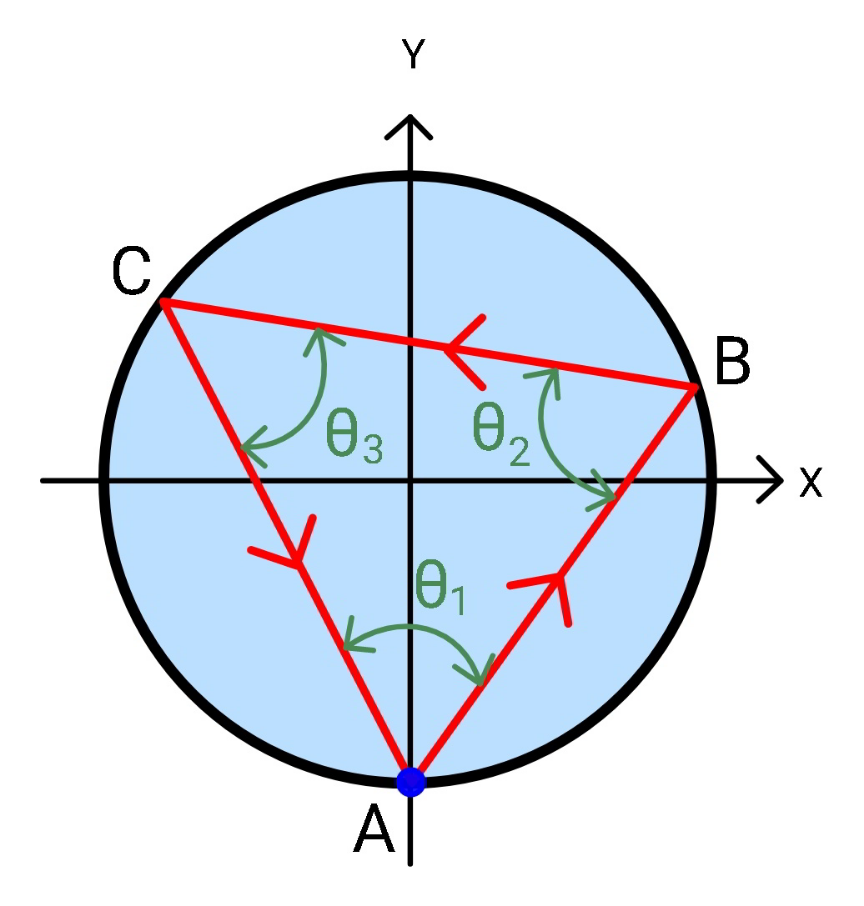Question Number 133487 by mr W last updated on 22/Feb/21

Commented by mr W last updated on 22/Feb/21

$${a}\:{ball}\:{is}\:{projected}\:{along}\:{the}\:{smooth} \\ $$$${floor}\:{and}\:{returns}\:{back}\:{after}\:{two} \\ $$$${times}\:{impact}\:{with}\:{the}\:{circular}\:{wall}. \\ $$$${if}\:{the}\:{restitution}\:{coefficient}\:{is}\:{e}, \\ $$$${find}\:{the}\:{angles}\:{of}\:\Delta{ABC}. \\ $$
Answered by mr W last updated on 22/Feb/21

Commented by mr W last updated on 23/Feb/21

$${at}\:{point}\:{B}: \\ $$$$\mathrm{tan}\:\beta=\frac{\mathrm{tan}\:\alpha}{{e}} \\ $$$${at}\:{point}\:{C}: \\ $$$$\mathrm{tan}\:\gamma=\frac{\mathrm{tan}\:\beta}{{e}}=\frac{\mathrm{tan}\:\alpha}{{e}^{\mathrm{2}} } \\ $$$$\mathrm{2}\left(\alpha+\beta+\gamma=\pi\right. \\ $$$$\Rightarrow\alpha+\beta=\frac{\pi}{\mathrm{2}}−\gamma \\ $$$$\mathrm{tan}\:\left(\alpha+\beta\right)=\mathrm{tan}\:\left(\frac{\pi}{\mathrm{2}}−\gamma\right)=\frac{\mathrm{1}}{\mathrm{tan}\:\gamma} \\ $$$$\frac{\mathrm{tan}\:\alpha+\frac{\mathrm{tan}\:\alpha}{{e}}}{\mathrm{1}−\frac{\mathrm{tan}^{\mathrm{2}} \:\alpha}{{e}}}=\frac{\mathrm{1}}{\frac{\mathrm{tan}\:\alpha}{{e}^{\mathrm{2}} }} \\ $$$$\frac{\left(\mathrm{1}+{e}\right)\mathrm{tan}\:\alpha}{{e}−\mathrm{tan}^{\mathrm{2}} \:\alpha}=\frac{{e}^{\mathrm{2}} }{\mathrm{tan}\:\alpha} \\ $$$$\left(\mathrm{1}+{e}+{e}^{\mathrm{2}} \right)\mathrm{tan}^{\mathrm{2}} \:\alpha={e}^{\mathrm{3}} \\ $$$$\Rightarrow\mathrm{tan}\:\alpha={e}\sqrt{\frac{{e}}{\mathrm{1}+{e}+{e}^{\mathrm{2}} }} \\ $$$$\Rightarrow\mathrm{tan}\:\beta=\sqrt{\frac{{e}}{\mathrm{1}+{e}+{e}^{\mathrm{2}} }} \\ $$$$\Rightarrow\mathrm{tan}\:\gamma=\frac{\mathrm{1}}{{e}}\sqrt{\frac{{e}}{\mathrm{1}+{e}+{e}^{\mathrm{2}} }} \\ $$$$\mathrm{tan}\:\left(\alpha+\beta\right)=\frac{\left(\mathrm{1}+{e}\right)\sqrt{\frac{{e}}{\mathrm{1}+{e}+{e}^{\mathrm{2}} }}}{\mathrm{1}−{e}×\frac{{e}}{\mathrm{1}+{e}+{e}^{\mathrm{2}} }}=\sqrt{{e}\left(\mathrm{1}+{e}+{e}^{\mathrm{2}} \right)} \\ $$$$\mathrm{tan}\:\left(\beta+\gamma\right)=\frac{\left(\mathrm{1}+\frac{\mathrm{1}}{{e}}\right)\sqrt{\frac{{e}}{\mathrm{1}+{e}+{e}^{\mathrm{2}} }}}{\mathrm{1}−\frac{\mathrm{1}}{{e}}×\frac{{e}}{\mathrm{1}+{e}+{e}^{\mathrm{2}} }}=\frac{\sqrt{{e}\left(\mathrm{1}+{e}+{e}^{\mathrm{2}} \right)}}{{e}^{\mathrm{2}} } \\ $$$$\mathrm{tan}\:\left(\gamma+\alpha\right)=\frac{\left(\frac{\mathrm{1}}{{e}}+{e}\right)\sqrt{\frac{{e}}{\mathrm{1}+{e}+{e}^{\mathrm{2}} }}}{\mathrm{1}−\frac{{e}}{\mathrm{1}+{e}+{e}^{\mathrm{2}} }}=\frac{\sqrt{{e}\left(\mathrm{1}+{e}+{e}^{\mathrm{2}} \right)}}{{e}} \\ $$$$\Rightarrow\theta_{\mathrm{1}} =\gamma+\alpha=\mathrm{tan}^{−\mathrm{1}} \frac{\sqrt{{e}\left(\mathrm{1}+{e}+{e}^{\mathrm{2}} \right)}}{{e}} \\ $$$$\Rightarrow\theta_{\mathrm{2}} =\alpha+\beta=\mathrm{tan}^{−\mathrm{1}} \sqrt{{e}\left(\mathrm{1}+{e}+{e}^{\mathrm{2}} \right)} \\ $$$$\Rightarrow\theta_{\mathrm{3}} =\beta+\gamma=\mathrm{tan}^{−\mathrm{1}} \frac{\sqrt{{e}\left(\mathrm{1}+{e}+{e}^{\mathrm{2}} \right)}}{{e}^{\mathrm{2}} } \\ $$$${example}:\:{e}=\mathrm{0}.\mathrm{5} \\ $$$$\theta_{\mathrm{1}} =\mathrm{tan}^{−\mathrm{1}} \frac{\sqrt{\mathrm{14}}}{\mathrm{2}}=\mathrm{61}.\mathrm{87}° \\ $$$$\theta_{\mathrm{2}} =\mathrm{tan}^{−\mathrm{1}} \frac{\sqrt{\mathrm{14}}}{\mathrm{4}}=\mathrm{43}.\mathrm{09}° \\ $$$$\theta_{\mathrm{3}} =\mathrm{tan}^{−\mathrm{1}} \sqrt{\mathrm{14}}=\mathrm{75}.\mathrm{04}° \\ $$
Commented by mr W last updated on 23/Feb/21

Commented by mr W last updated on 23/Feb/21

Commented by mr W last updated on 23/Feb/21

Commented by mr W last updated on 23/Feb/21

Commented by mr W last updated on 23/Feb/21

$$\boldsymbol{{background}}\:\boldsymbol{{knowledge}}: \\ $$$$\left({see}\:{also}\:{Q}\mathrm{132102}\right) \\ $$
Commented by mr W last updated on 23/Feb/21

